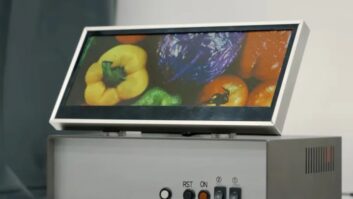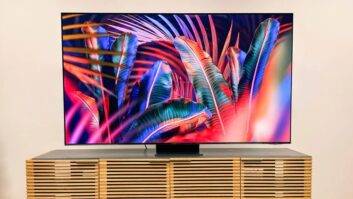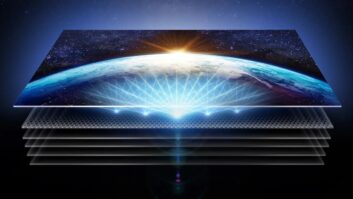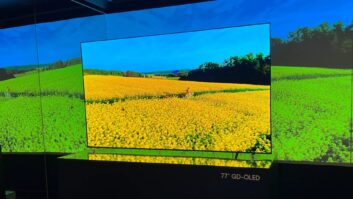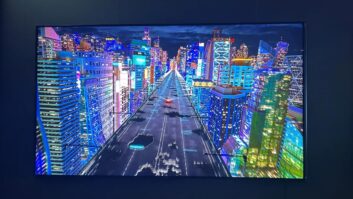LAS VEGAS – In the months and weeks prior to International CES, key display manufacturers began cueing up their positions in the battle for next-generation TV display supremacy.
The primary contenders are arch rivals Samsung and LG Electronics, which have taken divergent positions with LG continuing to push forward with its WRGB approach to OLED technology in bigger and better 4K Ultra HD configurations, while Samsung has put its OLED TV marketing plans on the back burner and is venturing into a relatively new area (for Samsung) with LED LCD TVs employing quantum dot technology.
In television displays, quantum dot technology produces an extremely wide color gamut, making it ideal for 4K Ultra HD content.
A variety of approaches to quantum dot displays have been proposed but, in general, the technology works by harnessing nanocrystals that range in size from 2 to 10 nanometers. Each dot emits a different color depending on its size and is triggered by an electrical current. Smaller dots are nearer the violet end of the visible light spectrum, while the larger ones are at the red end.
The nano-sized dots are said to emit extraordinarily vivid colors, and therefore help to enhance the already demonstrably better capabilities of 4K Ultra HD displays. By adding a film of quantum dots in front of the LCD backlight, picture color reproduction rate and overall brightness are significantly improved.
Some quantum dot supporters believe that the technology’s broader colors offer an improvement to picture quality that is even more demonstrable in FullHD displays than the expanded pixel resolution in some Ultra HD TVs, noted Erik Jostes, LCD business director of 3M, which manufactures films for one method of quantum dot technology.
Similarly, some analysts following the TV display market feel quantum dot technology could make it hard for some consumers to justify the extra price step to OLED TVs, which LG Electronics has trumpeted as the future of television.
“QD is potentially a big spoiler for OLED as it’s another thing that allows LCD to get near-OLED performance,” said Paul Gray, IHS/DisplaySearch principal analyst. “These are semiconductor nanocrystals that exhibit a range of unusual electrical and optical properties, but for decades they were largely confined to research laboratories. Now, quantum dots are being used in mass-produced displays for the consumer market, including such items as Sony flat-screen televisions and Amazon.com’s Kindle Fire HDX.”
With LG building momentum behind the infinite blacklevel and contrast performance of its new-generation 4K Ultra HD OLED displays, manufacturers including Sony, Samsung, TCL and others have jumped on the quantum dot express.
QD Vision, which produces a QD film under the Color IQ trade name, has had its technology used in Sony’s Bravia TVs, which have thus far sold more than 2 million units around the world. TCL has announced that it too will use Color IQ in a line TVs it will export around the world this year.
QD Vision’s Color IQ “QLED technology is the only way to produce large displays that deliver a full color gamut experience at an affordable price. Today, we help our partners deliver QLED televisions that deliver better color than OLED at a fraction of the cost,” said Matt Mazzuchi, QD Vision VP. “We do this by leveraging the existing LCD supply chain infrastructure, which will be used to produce more than 99 percent of all TVs in 2015. So QLED has a much better chance of significant penetration into the TV market than OLED because we don’t require manufacturers to make big investments in new equipment, fabs, or backplane technology.”
QD Vision said that LCD panels can only natively reproduce 60 to 70 percent of the NTSC color standard, but by adding its Color IQ film, those same panels can reach the full 100 percent. Nanosys and 3M have developed a similar approach for quantum dot displays which is called QD Enhancement Film (QDEF).
This QDEF technology is said to bring a 50 percent wider color gamut and lower power consumption than typical LED LCD panels.
Earlier last year, Samsung Display trademarked the name QDOT-TV to indicate LCD TVs using new quantum dot LED backlighting it is adopting, and will show lines of quantum dot enhanced sets at CES this week.
“I think Samsung decided that 4K OLED was a step too far at this time with their process, and OLED as a top tier product needed to have 4K,” said Gray. “That’s a big problem for 55-inch, and really similar to 1080p PDP, which only Panasonic mastered. Fine pixel structures combined with large sizes is a challenge for any emissive technology. I’m sure that Samsung continues to tinker with large OLED; in the meantime, they are learning loads in OLED for smartphones, and making money from doing so.”
The approach is different from previous quantum dot approaches like Sony’s Triluminos Display technology, based on QD Vision’s Color IQ technology.
Even LG Electronics itself revealed in the weeks leading up to CES that it too would market a line of quantum dot 4K UHD LED LCD TVs in 2015.
But unlike its rivals, LG is still holding up OLED as the future of television, and quantum dot as another more affordable price step on the way to the “holy grail” of TV displays.
Meanwhile, quantum dots aren’t the only new 4K UHD LED LCD TV technologies planned for introduction this year.
Sharp is showing the next evolutionary step for its Q+ pixel-splitting technology it introduced in lines of Aquos FullHD TVs last year, in an 80-inch Aquos 4K Ultra HD set, using the same approach on a panel with four times the base native resolution of FullHD.
Sharp said the technology will produce the “highestresolution 4K UHD TV” yet available.
The new TV, which will be released in an 80-inch screen size, is able to take a 3,840 by 2,160 resolution screen and produce an effective resolution of 7,680 by 4,320, Sharp said.
Sharp said the TV splits pixels in half vertically and enables subpixel areas to independently create separate color values resulting in 66 million independently controlled subpixels.
This is 42 million more subpixels than standard 4K UHD.
Also, P&F USA is showing a pair of new 4K Ultra HD LCD TVs that use a cyan LED backlight in combination with red laser lighting to produce a picture that produces better balance between green and blue pixels, along with deeper, truer shades of red from the laser.
The company will produce under the Philips brand in the U.S. in 2015 two 4K Ultra HD smart laser LED TVs in the 58- and 65-inch screen sizes. The company’s new flagship sets will also incorporate a highfidelity 60-watt sound system with narrow speakers running from top to bottom on each side of the screen.
Other features include 240Hz refresh rates for smooth natural colors of fast-moving subjects, and Philips’ smart-TV platform handling 4K streaming with HEVC and VP9 CODEC compatibility.








